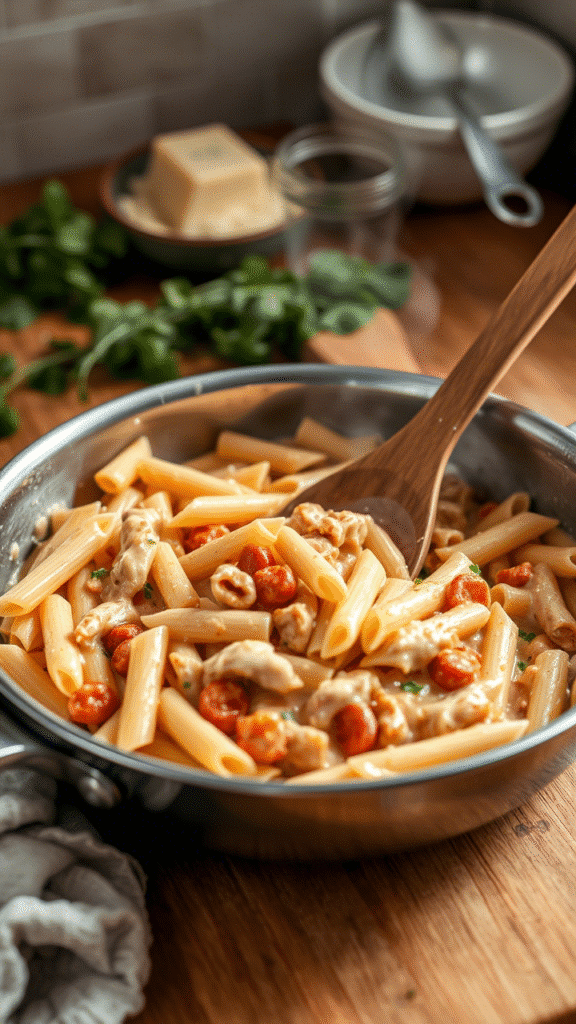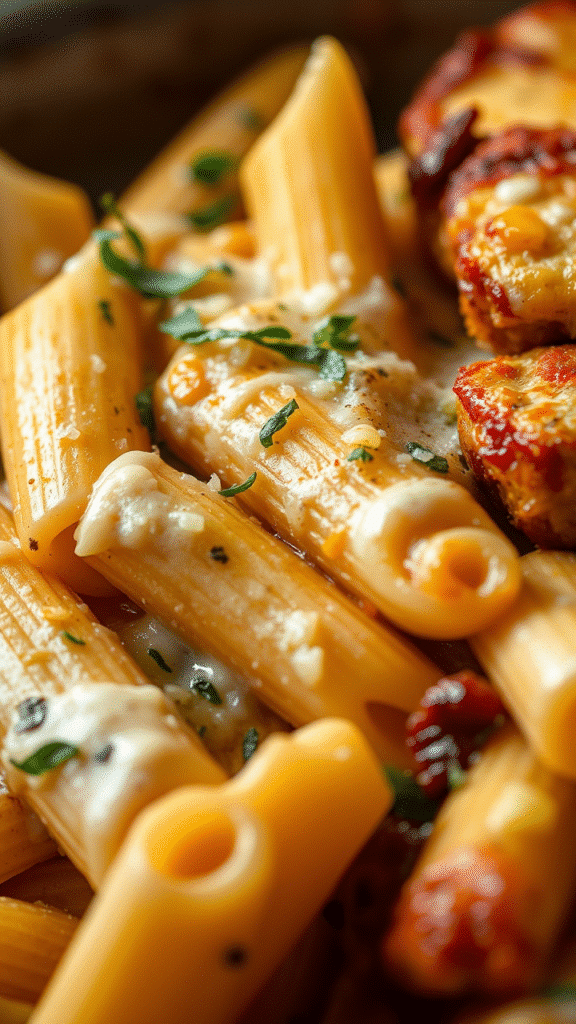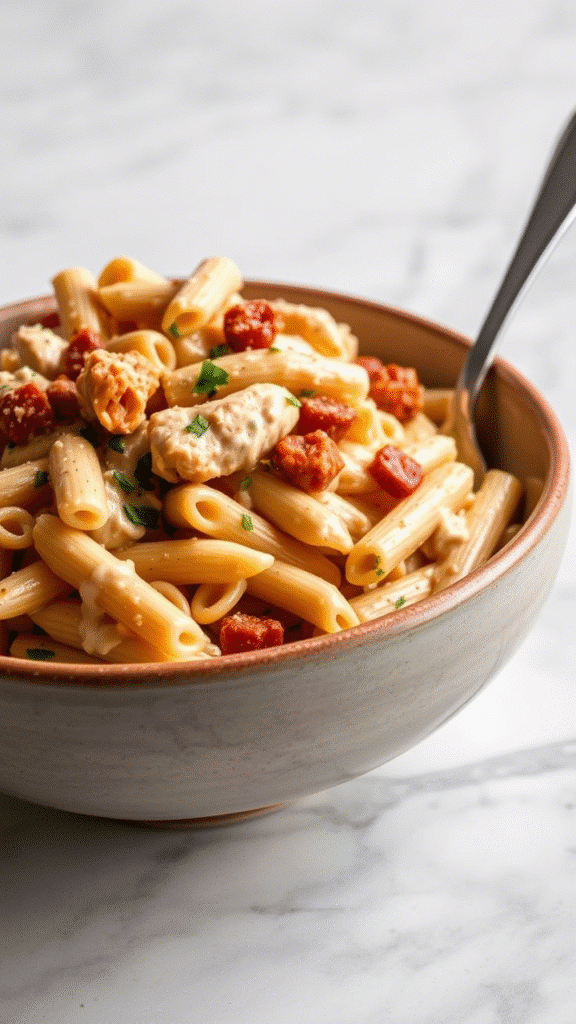Picture this: you’re standing in your kitchen on a Tuesday evening, staring at that same old rotation of weeknight dinners. Then you remember that half-used chorizo sitting in your fridge and those chicken thighs you meant to cook yesterday. What if I told you these humble ingredients could transform into something extraordinary? Something that makes your neighbors peek over the fence, wondering what smells so incredible?
Creamy Chicken Chorizo Pasta isn’t just another fusion dish—it’s a masterclass in how contrasting flavors can dance together in perfect harmony. The smoky, paprika-laden chorizo brings Spanish soul to the party, while tender chicken and silky cream sauce ground it in comfort food tradition. This dish proves that some of the best cooking happens when you let ingredients from different culinary worlds have a conversation on your plate.
What Makes This Recipe Special
The magic lies in the layering of flavors. Unlike traditional pasta dishes that rely on one dominant sauce, this recipe builds complexity through technique. The chorizo renders its oils first, creating a flavor base that infuses every component. The chicken browns in those rendered fats, picking up smoky notes. Even the pasta water becomes part of the symphony, helping to create a sauce that clings perfectly to each strand.
Professional kitchens have long understood this principle: fat equals flavor, and when you use that fat strategically, you create dishes that taste like they’ve been simmering for hours, even when they haven’t.
Ingredients & Substitutions

The Protein Foundation
Spanish Chorizo (6 oz, diced): This is your flavor engine. Look for dry-cured chorizo, not the Mexican fresh variety. The oils that render out become the foundation of your entire dish. If you can’t find Spanish chorizo, Portuguese chouriço works beautifully, or try a high-quality pepperoni as an emergency substitute.
Chicken Thighs (1.5 lbs, boneless, skinless): Thighs over breasts every time. The higher fat content means they stay juicy even when seared aggressively. Bone-in thighs work too—just extend the cooking time and remember to remove the bones before serving. In a pinch, chicken breasts can work, but slice them thin and don’t overcook.
The Pasta Platform
Penne or Rigatoni (1 lb): The tubes and ridges aren’t just for show—they grab onto that creamy sauce like tiny flavor vehicles. Paccheri works magnificently if you can find it. Short pasta shapes with texture are key; avoid smooth varieties like ziti that let the sauce slip away.
The Aromatics
Yellow Onion (1 medium, diced): The sweet foundation that balances the chorizo’s intensity. Red onions add too much bite here; white onions lack the depth. Shallots can elevate the dish if you’re feeling fancy, but yellow onions are the reliable choice.
Garlic (4 cloves, minced): Fresh only. Jarred garlic has no place in a dish this nuanced. The oils released when you crush fresh garlic create aromatic compounds that powder simply can’t replicate.
Bell Peppers (2 medium, any color): Red peppers add sweetness; yellow brings subtle floral notes; green provides earthiness. Mix colors for visual appeal, but avoid using only green—the bitterness can overwhelm the delicate cream sauce.
The Liquid Elements
Heavy Cream (1 cup): This isn’t the place for half-and-half or milk. The fat content in heavy cream prevents curdling when it meets the acidic tomatoes and wine. European-style cream with higher fat content (36% vs 35%) creates even more luxurious results.
White Wine (½ cup): Dry whites like Pinot Grigio or Sauvignon Blanc work best. The acidity cuts through the richness while adding depth. If alcohol is off-limits, use chicken stock with a splash of white wine vinegar.
Chicken Stock (1 cup): Homemade is ideal, but quality store-bought works. Low-sodium gives you control over seasoning. Avoid anything labeled “broth”—stock has more body from the gelatin.
The Supporting Cast
Crushed Tomatoes (1 can, 14.5 oz): San Marzano if your budget allows, but any quality crushed tomatoes work. Whole tomatoes that you crush yourself often have better texture than pre-crushed varieties.
Smoked Paprika (1 tsp): This amplifies the chorizo’s smokiness without adding heat. Sweet paprika works too, but you’ll lose that campfire depth that makes the dish memorable.
Fresh Thyme (2 tsp): The earthiness bridges the Spanish and Italian elements. Dried thyme in a pinch, but use half the amount. Oregano can substitute, but it pushes the dish more Italian than Spanish.
Parmesan Cheese (½ cup, grated): Parmigiano-Reggiano aged 24 months minimum. The crystalline texture and nutty complexity can’t be replicated by the stuff in the green can. Pecorino Romano adds salt and sharpness if you prefer.
Step-by-Step Instructions

Building the Foundation
Start with your chorizo in a cold, large skillet or Dutch oven. This isn’t the time for non-stick—you want that fond building on the bottom. Cook over medium heat, stirring occasionally, until the chorizo has rendered its oils and developed crispy edges, about 6-8 minutes. The smell will tell you when it’s ready—that moment when the paprika oils start to perfume your kitchen.
Remove the chorizo with a slotted spoon, leaving behind those precious rendered fats. This is liquid gold, don’t waste it.
Searing the Chicken
Season your chicken generously with salt and pepper. The chorizo will add saltiness later, but the chicken needs seasoning now to develop proper flavor. Pat the thighs dry with paper towels—moisture is the enemy of a good sear.
Increase heat to medium-high and add the chicken to the chorizo fat. Don’t move it for the first 4-5 minutes. You want to hear that aggressive sizzle. The chicken is ready to flip when it releases easily from the pan. If it’s sticking, it’s not ready.
Cook until golden brown on both sides, about 8-10 minutes total. The chicken doesn’t need to be fully cooked at this stage—it’ll finish in the sauce. Remove to a plate and tent with foil.
The Aromatic Base
Reduce heat to medium and add your diced onion to the same pan. Those brown bits on the bottom (the fond) will dissolve into the onions, adding layers of flavor. Cook until translucent, about 5 minutes. If the fond is getting too dark, add a splash of stock to deglaze.
Add the bell peppers and cook for another 4-5 minutes until they start to soften. The peppers should still have some bite—they’ll continue cooking in the sauce.
Stir in the garlic and thyme, cooking just until fragrant, about 30 seconds. Garlic burns quickly, so keep it moving in the pan.
Deglazing and Building the Sauce
Pour in the white wine, scraping up any remaining fond from the bottom of the pan. Let it bubble vigorously for 2-3 minutes to cook off the alcohol. You’ll know it’s ready when the sharp alcohol smell mellows into something more wine-like.
Add the crushed tomatoes, smoked paprika, and chicken stock. Bring to a simmer, then nestle the chicken back into the sauce along with any accumulated juices. The chicken should be mostly submerged.
Cover and simmer for 15-20 minutes until the chicken reaches 165°F internal temperature. Remove the chicken again and slice into bite-sized pieces.
The Pasta Dance
While the chicken simmers, cook your pasta according to package directions until al dente. Reserve 1 cup of pasta water before draining—this starchy liquid is crucial for sauce consistency.
The timing here is critical. Your pasta should finish cooking just as your sauce comes together. Cold pasta absorbs sauce poorly, so work quickly.
Bringing It All Together
Reduce the heat to low and slowly stir in the heavy cream. Don’t let it boil—cream can break if it gets too hot too fast. Add the sliced chicken and cooked chorizo back to the sauce.
Add the drained pasta to the sauce, not the other way around. This ensures even coating. Toss everything together, adding pasta water a splash at a time until the sauce coats the pasta beautifully. You want it creamy but not thick like pudding.
Remove from heat and stir in half the Parmesan cheese. Taste and adjust seasoning—the chorizo and cheese bring saltiness, so you might not need much additional salt.
Cooking Techniques & Science
The success of this dish hinges on understanding fat-soluble flavor compounds. Chorizo’s paprika and garlic release their most intense flavors when heated in fat, not water. This is why we render the chorizo first—those oils become infused with concentrated flavor that permeates every other ingredient.

The Maillard reaction—the browning of proteins and sugars—happens when we sear the chicken and let the chorizo develop crispy edges. These caramelized surfaces add depth and complexity that simply can’t be achieved through gentler cooking methods.
When cream meets acid (from the tomatoes and wine), it can curdle if the temperature spikes too quickly. Professional kitchens temper cream by adding it slowly to warm, not hot, mixtures. The proteins in cream need time to adjust to temperature changes.
The pasta water isn’t just for consistency—its starch content acts as an emulsifier, helping the fat-based chorizo oils bind with the water-based cream sauce. This creates a cohesive sauce that clings to each piece of pasta instead of sliding off.
Serving & Pairing Suggestions
Serve immediately in warmed bowls—this dish loses its magic as it cools. A sprinkle of fresh chopped parsley adds color and a bright note that cuts through the richness. Extra Parmesan at the table never goes amiss.
For wine pairings, think medium-bodied reds that can stand up to the chorizo’s intensity. A Spanish Tempranillo honors the chorizo’s heritage, while an Italian Chianti Classico plays beautifully with the cream and tomatoes. If white wine is preferred, a rich Chardonnay with some oak complements the creaminess.
Side dishes should be light and acidic to balance the richness. A simple arugula salad with lemon vinaigrette works perfectly. Crusty bread is tempting but unnecessary—this pasta is rich enough to stand alone.
For presentation, twirl the pasta high in the center of the bowl, then arrange chicken and chorizo pieces around the edges. A light dusting of smoked paprika and a few fresh thyme sprigs turn a weeknight dinner into something restaurant-worthy.
Conclusion
Creamy Chicken Chorizo Pasta represents everything I love about fusion cooking—it respects the integrity of its source ingredients while creating something entirely new. The key to success lies in understanding how each component contributes to the whole. The chorizo provides the flavor foundation, the chicken adds protein and substance, and the cream ties everything together into comfort food perfection.
Remember that cooking is about building layers of flavor. Each step—from rendering the chorizo to tempering the cream—serves a purpose in creating the final dish. Don’t rush these steps, and don’t skip the fond. Those caramelized bits stuck to your pan contain concentrated flavor that can’t be replicated any other way.
The beauty of this recipe lies in its flexibility. Once you understand the technique, you can adapt it to your taste. More heat? Add red pepper flakes with the garlic. Want it lighter? Use half cream, half stock. Prefer a different protein? Italian sausage works beautifully in place of chorizo.
Most importantly, taste as you go. Your palate is the best guide for seasoning and balance. Every chorizo brand has different salt levels, every cream varies in richness. Trust your taste buds over any recipe, including this one.
Frequently Asked Questions?
Can I make this dish ahead of time?
Cream sauces don’t typically reheat well, but this one is more forgiving due to the chorizo oils. Store leftovers in the refrigerator for up to three days. When reheating, add a splash of cream or pasta water to restore the sauce consistency. Heat gently over low heat to prevent the cream from breaking.
What if I can’t find Spanish chorizo?
Portuguese chouriço is the closest substitute, followed by high-quality pepperoni. Italian sausage changes the flavor profile but still creates a delicious dish. Avoid Mexican fresh chorizo—it has different texture and spicing that won’t work in this application.
Can I use a different type of pasta?
Short, tubular shapes work best because they hold the sauce. Fusilli, rotini, or even shells can substitute for penne or rigatoni. Long pasta like spaghetti or fettuccine can work, but the sauce won’t cling as effectively. Avoid delicate pasta like angel hair—it can’t support this hearty sauce.
How do I prevent the cream from curdling?
Temperature control is key. Never let the cream boil once it’s added to the sauce. If your sauce does break, remove it from heat immediately and whisk in a tablespoon of cold cream. Sometimes the sauce can be saved by blending with an immersion blender, but prevention is better than repair.
Is there a lighter version of this recipe?
Replace half the heavy cream with whole milk or chicken stock, but add it gradually to prevent curdling. Greek yogurt can work as a cream substitute, but add it off the heat and don’t let the sauce boil afterward. The dish will be lighter but won’t have the same luxurious mouthfeel.

Veronica is a passionate food enthusiast with over three years of experience in exploring and writing about diverse cuisines. Her expertise lies in reviewing restaurants, sharing creative recipes, and discovering the latest food trends. As the voice behind FoodieRecap.com, Anju brings fresh perspectives and culinary insights to her audience.
